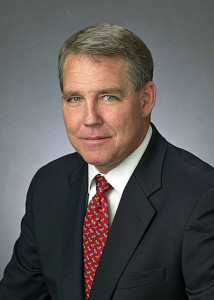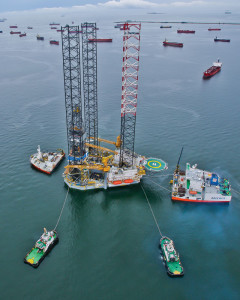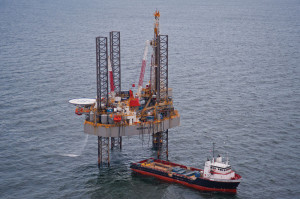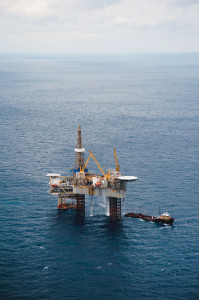Industry must sustain steadfast focus on wellbore, critical path
Increase in regulations, rig inspections in US Gulf must not distract rig crews away from truly safety-critical tasks
By Linda Hsieh, managing editor
 John Rynd is CEO and president of Hercules Offshore and 2014 IADC vice chairman.
John Rynd is CEO and president of Hercules Offshore and 2014 IADC vice chairman.
At an industry event last year, you spoke of near-historical highs for contractor backlogs and how that is providing marketing flexibility and pricing support. Do you see that trend continuing into 2014 or even 2015? Is this financial visibility impacting contractors’ investment decisions?
We see the trend continuing into 2014 for sure because we have a number of rigs already contracted well into the year. We even have one rig contracted into 2015. But we must remember this is a cyclical business, and the overall industry environment still depends on commodity prices. That’s what drives our business. Some pundits are predicting $65 oil, which would cause a slowdown, but right now things look solid into 2015.
Having improved visibility of earnings and cash flow has made it easier for us to make investment decisions. That was a key factor in our decision to buy out the remaining ownership in Discovery Offshore without issuing any equity.
Is this type of financial visibility something contractors hadn’t seen before, at least in recent years?
Not on the US shelf. We’ve seen it outside the US, where two- and three-year contracts are more common. The US Gulf has historically been a well-to-well environment, but that has been slowly shifting since late 2011 due to the low rig count and increased demand. It’s resulted in solid backlogs and good visibility.
What is supporting this change on the US shelf?
Rigs have been slowly migrating out of the US Gulf since around 2000 to seek international opportunities. At the time, there were very few rigs, if any, under construction, so the US was really the largest repository of jackups. It became a natural draw for the international jackup market.
Then we lost about 17 jackups to hurricanes Katrina and Rita in 2005 and Ike in 2008, and this really tightened the worldwide jackup supply.
The financial crisis starting in late 2008 also halted a lot of drilling on the US shelf. A lot of rigs were stacked, and anybody that could, left for opportunities in other markets. Then, of course, we had the moratorium, which was another blow on the demand cycle for six to eight months.
If you look at the world today, the same factors that drove rigs out of the Gulf – lack of term work compared with other markets, higher tax rates, higher insurance costs, higher labor costs – they are still here. On top of that, post-Macondo we have more political uncertainty here than we’ve ever faced before. In this scenario, it’s hard to see a large number of rigs moving back into the Gulf, at least through 2015, and that’s going to keep the supply tight.
I also don’t see newbuild jackups moving into the US market because the contracts here don’t support newbuild costs. Further, the wells that are typically drilled on the shelf are drilled very effectively by the older rigs. There’s really not a need for the additional capabilities of the newer rigs.

So the shift from natural gas to oil/liquids-rich projects in the US Gulf hasn’t affected operators’ rig requirements or technology needs?
Not yet. We’re still drilling conventional wells that the older assets can drill very effectively. The shift has really been economically driven due to all the gas coming from the onshore resource plays. It’s hard for offshore to compete at $3 gas, so our customers shifted. There continues to be a lot of seismic work being done in the shallow water, and approximately
$8 billion of new investments have been put in on shelf properties since around 2010. The flush of new capital will continue to drive reinvestment in the shelf and therefore a very optimistic outlook.
Offshore drilling contractors have had to continually adjust to new operational and regulatory requirements since Macondo. What have been some of the most significant changes Hercules has made in the past 2-3 years in order to comply with new rules?
First, I want to emphasize that we fully support the Interior Department’s efforts to ensure that offshore drilling is conducted safely. That said, I think there is a common misconception that our industry does not have safe operations and that we had to be “remade” after Macondo. In fact, the vast majority of the industry has long been ahead of the curve, adopting many of the best practices that the regulatory community is now embracing. For example, we adopted safety management systems long before they became legally required. The same can be said for stop work authority, which we’ve had in the business for as long as we can remember. If anybody on the rig isn’t comfortable with what’s going on, they have the right and the obligation to stop the operation.
We did see a flurry of regulations after Macondo, but a lot of that was formalizing what we already had into a regulatory framework. It was getting a third party to reaffirm that our equipment, policies and procedures were right.
The biggest change we’ve seen over the past two to three years has actually been the evolving focus on rig and platform inspections and the increase in the number of incidents of noncompliance, or INCs, that have been issued.
I emphasize again that we don’t have any problems with having rules and regulations, but I don’t think you can “INC” your way to safety. The emphasis should be on the quality of the INCs rather than the quantity.
I believe that inspection efforts should be focused on areas that truly make us safer operationally. We need to look at whether all these INCs are really adding value. Are we getting ourselves and our crews off the critical path at the wellsite and not focused on the real safety of our people?
Is the result of these INCs that too much focus is being directed to compliance rather than actual safety?
We’re definitely concerned that the focus is being lost amid an inundation of rules of regulations around things that are not core to making us safer. What we need to be focusing on are the wellbore, the rig floor and the people. You don’t want your people offshore distracted from what their mission is.
You mentioned that the moratorium was a factor in driving rigs out of the US Gulf and how that led to a lower jackup count that continues today. Are there other long-term effects from the 2010 shutdown?
Since Macondo, our customers have had to work harder and wait longer for drilling permits, but I think we’ve all adapted very quickly. I would say the biggest hangover from the moratorium is the continued regulatory uncertainty. The pace of new rules and regulations has waned since 2011, but the uncertainty remains.
New rules continue to trickle out of the regulators, and new rules loom on the horizon. For example, the industry has been anticipating the new BOP rule for more than two years. Although it’s likely to focus on subsea BOPs, there’s significant concern about what and how BOPs will be regulated. The industry, as well as IADC, is fully engaged with regulators to ensure the new rules make sense and will efficiently and effectively accomplish their goals of making offshore drilling safer.
You also mentioned insurance costs as a factor for rigs leaving the Gulf of Mexico. What are the current challenges with insurance?
The issue is really with wind insurance. Hurricanes Katrina, Rita, Ivan and Ike really drove costs up. In fact, insurance premiums are so high that many contractors are either partially or fully uninsured for damage caused by named hurricanes. They’ve had to take on that risk themselves.

Since Macondo, liability risk also increased significantly, and some of the legal rulings that have come out of Macondo-related litigation have been troubling. The enforceability of indemnities in drilling contracts is still to be litigated, adding another unknown to our business. It could mean another layer of cost to insurance for drillers.
How are drilling contractors addressing these risks?
At Hercules, we’ve tightened up our drilling contracts, and our insurance underwriters have introduced new provisions into our insurance policies to try to alleviate the uncertainty. However, overall we’re still in a wait-and-see situation.
At the IADC Annual General Meeting in late 2013, a keynote speaker from a major operator spoke about the need for collaboration on BOP reliability and safety management systems. Do you indeed see more engagement between operators and contractors in these two areas? What are the challenges?
Since Macondo, we have seen and benefitted from a greater level of collaboration between operators and contractors on a number of important issues, but there are challenges. First, contractors have historically been primarily, if not exclusively, responsible for BOP maintenance. We own it, and it’s ours to take care of. Second, we obviously work for a large number of operators over the life of any particular BOP. Having to modify maintenance practices from operator to operator is not efficient and effective. That’s where the collaboration has to come in.
BOP manufacturers are taking an increasing role in monitoring and tracking the performance of the BOPs over time, but this too has challenges because the BOP is constantly inspected and maintained – and even broken down and rebuilt.
Do you think industry should work toward standardized procedures on how to maintain BOPs?
If we’re going down a path where every operator is going to have its own standards, then yes, it does make sense to have a benchmark of standards across industry.
There was also much discussion at the IADC Annual General Meeting about proposed energy reforms in Mexico. What impact could that have on the US jackup market or even the global jackup market?
Hercules was active in Mexico up until two years ago. It has historically been a key jackup market and will continue to be a key market for the global jackup business. Currently they have about 42 jackups contracted, and they typically go for three to five years, so they do command a significant supply. They’ve already run above their historical average over the past decade in terms of number of rigs. The energy reform could cause a big shift in demand where a lot of rigs migrate to Mexico, and that would be a positive development for everybody in our industry.
What critical challenges do you see in some of the other jackup markets around the world?
Our largest market outside the US Gulf is Saudi Arabia, where we have three jackups contracted to Saudi Aramco. We were recently awarded five-year contracts for two of these rigs that will extend their stay with Saudi Aramco until Q4 2019.
Like any international locale, there are some country-specific risks. However, Saudi has been very stable, and I think they work very hard to remain stable. They realize the importance of their stability to the global market.
West Africa is another key market for us. We have two jackups and 21 lift boats in the region. I think there will be growth in the future from a jackup perspective, but there are political risks and social instability across all fronts. The largest exposure there is Nigeria. We’ve had very little disruption, but it takes a lot of effort to be safe and secure and to understand how to conduct business there.

Do you see challenges as far as finding people to crew your rigs in the non-US markets?
Without a doubt, qualified labor is the biggest challenge the industry faces. Local labor requirements in some countries also add to the challenge. We’ve been able to manage it so far, but as you look out over the next three years, the Great Crew Change is going to happen. It got delayed due to the financial crisis and the global business slowdown, but now if you look at the number of rigs that are scheduled to be delivered through 2016, attracting and retaining people will definitely be a big challenge going forward.
Jackups have become larger and more sophisticated in recent years. In what areas will future jackup improvements focus on?
They are getting bigger and more robust because wells around the world are getting more complex and require larger equipment, whether it’s horsepower, hydraulic horsepower, deck space, hookload, etc. This was definitely a driver when we bought the two Discovery Offshore rigs – the Hercules Triumph and the Hercules Resilience. Wells are getting deeper and higher pressure so the industry needs more sophisticated equipment like these rigs to drill the wells.
The second of those two newbuilds was just delivered in December. What is your outlook on additional newbuilds?
For us, it doesn’t feel like the right time for additional newbuilds at the moment. We see approximately 125 jackups on order or under construction right now. That’s a lot of rigs that will be coming out in front of you if you order now.
However, a number of rigs have been ordered by pure speculators. We’re monitoring those that have earlier delivery dates. In November we announced a management agreement with an investment company that’s building two high-specification jackups. We’re going to manage their jackups with a purchase option.
What are some new technologies or equipment Hercules is looking at implementing on its rigs to improve efficiency?
In my opinion, most of the technological advances in our business have been below the rotary table – seismic, horizontal drilling, fracturing. There haven’t been step-changes in recent years like with H&P’s FlexRigs or when Transocean did the dual derrick.
On jackups, I would say one significant change has been having a bigger platform to handle more stuff – more horsepower, more pumps, more derrick capacity. This allows you to do offline standbuilding so you can cut your flat spot time. The ability to jack up with a full preload onboard also has saved time. Hookload, horsepower and storage capacity is really where the jackups have moved.
In the onshore segment of the drilling market, there is some concern that the efficiencies of new rigs have led to operators needing fewer rigs to drill the same number of wells, and therefore a lower overall rig count. Do you have the same concern for the offshore market, i.e., are we building ourselves into another bust cycle?
We haven’t seen it to the level yet that you’ve seen on land. They have made a phenomenal step-change on land, if you look at how much footage one land rig drills versus what an offshore rig drills in a year. But I think some of the new jackups are going into areas that heretofore were not available for jackups to drill. That’s creating a new market, whether it be extended water depths out to 400 ft or 15k BOPs, which were mostly limited to floating rigs before. It’s kind of a new niche market, and there’s not as much rig-on-rig competition.
Back to your question, though, I do see two sides to the argument about drilling efficiency. Some people say it’s a negative for the driller because it means operators require fewer rigs. In my view, however, efficiency is always a positive because it means our customers have a bigger piece of their pie to drill more wells.
As you mentioned earlier, recruiting talent and ensuring they are competent is a critical challenge for the global drilling industry. Do you see contractors doing enough to formalize their competence assurance processes, and how can the IADC KSAs help?
Most major drilling contractors have always had competency programs. We knew it was the right thing to do, and it was the best way to provide the safest service for our employees and customers.
IADC’s KSAs initiative will bring significant benefits for the industry because it will set a benchmark for everyone. I also like IADC’s community college outreach through the Workforce Attraction and Development Initiative. I really like that we’re not just reaching out to the traditional areas of labor, such as the South and the Gulf Coast. It’s stretching out to other areas where we didn’t draw labor from previously.
At Hercules, one thing we did in 2012 was institute our management trainee program. We hired eight college graduates from various disciplines, and we’re putting them through a three-year program where they will work two weeks on a rig, and then a week in the office in various departments. The goal is to attract bright, smart and hard-working kids into our business and develop them into management. The trainees we hired came from a variety of backgrounds, including ocean engineering, aeronautical engineering, economics, geology and marketing. Each trainee is assigned a mentor in the office, and twice a year we have what we call “lunch with leaders,” which is open to all of our young employees so we can keep them abreast of what’s going on.
Operators continue to express a desire to see contractors implement and execute uniform operational/safety standards across their global operations. Should operational/safety standards be uniform across all rigs for a global company like Hercules?
Yes, without question, you can’t do it one way here and another way over there. You have to set the bar no matter where you’re operating and meet that standard. There will be language and cultural barriers, but best practice doesn’t change from location to location.
Our senior leaders understand what our goal and mission is, and they drive the operation. You do have local challenges, and sometimes it does take more training and patience to ensure new-hires are doing things the right way. But we’re willing to make that effort because the risks don’t change.
How do you think industry’s approach to risk management is evolving as its operations and operating environments get more difficult and more complex?
I think there’s a public misconception about our industry. If you look at our lost-time and total recordable incident track record, it clearly demonstrates that we’ve responded successfully and consistently to reduce our tolerance for risk. We try to do it right 365 days a year, and we continue to raise the bar. Initially we were focused on reducing lost-time incidents, and then that shifted to recordable incidents. Now we’re at the point where we focus on any incident, not necessarily an injury but any incident – it could be a dropped object or a crane failure.
The industry has had its mistakes, but overall we have a very solid record of managing our risks. We continue to embrace incident-free operations and believe we can do it. We’re recognizing that safety is operations; they’re one and the same.
